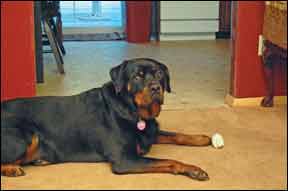Uh-oh. What’s this lump? Any growth on your dog’s body deserves attention, especially one that wasn’t there last time you checked. It could be a sebaceous cyst (a sac filled with sebum, a cheesy or oily material, caused by clogged oil glands in the skin), an abscess (a pus-filled swelling caused by infection), or – everyone’s worst nightmare – a cancerous tumor. But in most cases, the lumps we discover as we pet and groom our dogs are lipomas, which are benign (non-cancerous) fat deposits, also known as fatty tumors.
An estimated 1.7 million dogs are treated in the United States for lipomas every year, and according to one survey, American veterinarians average 25 lipoma removals annually at a cost to owners of $635 million.
Lipomas tend to emerge as dogs reach middle age and increase in number as dogs get older. A dog with one lipoma is likely to get more. Lipomas are most often found on the chest, abdomen, legs, or armpits (axillae). These fatty lumps aren’t painful and they usually stay in one place without invading surrounding tissue. Dogs aren’t the only animals with lipomas, as they are common in humans and parakeets, and they occasionally develop in cats and horses.

While canine lipomas are frequently associated with overweight females, their greatest risk factor may be genetic. “I’ve heard all kinds of theories,” says Tia Nelson, DVM, of Helena, Montana. “Some veterinarians are convinced that lipomas are the result of over-vaccination, commercial pet food, grain-based diets, and exposure to environmental toxins. Although most dogs with lipomas fit that description, I can show you plenty of lumpy dogs who were holistically raised on grain-free raw food and minimal vaccinations, including some of my own. The simple fact is that some dogs are going to develop lipomas no matter what you do.”
Any dog can be affected, but lipomas seem most common in Labrador Retrievers, Doberman Pinschers, Miniature Schnauzers, Cocker Spaniels, Dachshunds, Poodles, Terriers, and mixed breeds.
What To Do
Most lipomas are subcutaneous (occurring just beneath the skin’s surface) and are moveable, not attached to skin or underlying muscle or tissue. They are usually small and either round or oval, the size of a marble or marshmallow, and soft or rubbery to the touch. A few feel more solid due to fibrous tissue or inflammation. Some grow to golf-ball size, and very large lipomas can resemble baseballs. A few grow long and wide.
Because there’s no way to tell whether a lump is a lipoma just by feeling it, veterinarians remove and inspect fluid from inside the lump in a biopsy procedure called fine-needle aspiration to confirm that the growth contains only fatty cells. Some are concerned about the potential for fine-needle aspirate to spread cancer if the lump is not benign, and this concern is reasonable for tumors in the abdomen or heart (especially if they are filled with fluid, which can be determined with ultrasound) or in the urinary tract, including bladder and prostate. When aspirating subcutaneous solid tumors that might be confused with lipomas, however, the risk is small and outweighed by the advantages of having an accurate diagnosis.

The usual recommendation for fatty tumors is to wait and watch. Sometimes lipomas develop rapidly but in most cases their growth is slow. They rarely cause problems unless they become exceptionally large or their location creates mechanical problems. For example, a lipoma in the armpit can affect a dog’s gait, while one in the sternum (chest area) can cause discomfort whenever the dog lies down, and a lipoma in the neck area, if it grows large enough, can interfere with breathing and proper collar fit.
“I never do surgery on benign lipomas unless they are physically impeding ambulation or other function,” says Stacey Hershman, DVM, of Hastings-on-Hudson, New York. “I never remove a lipoma for cosmetic reasons since I have seen dogs get ill or go into liver failure after lipoma surgery even though their pre-op bloods were normal. Therefore I recommend to my clients that we leave them alone unless there is a medical reason to remove them. A few years ago a dog came in with such a huge lipoma under his armpit that he could not walk, and I removed it for functional reasons.”
Some lipomas grow so rapidly that they might be something else, such as a liposarcoma. This rare, malignant fatty tumor usually does not metastasize (spread to other parts of the body) although it can be aggressive and fast-growing. Other tumors that occur on or under the skin that could be mistaken for lipomas include sebaceous adenomas, mast cell tumors, hemangiosarcomas, and hemangiopericytomas. If there is any question about diagnosis, removal may be the safest option.
Occasionally lipomas invade con-nective tissue between muscles, tendons, bones, nerves, or joint capsules. Called infiltrative lipomas, these usually occur in the legs but can affect the chest, head, abdominal body wall, or perianal region. Infiltrative lipomas can cause pain, muscle atrophy, and lameness by interfering with movement. Unlike normal lipomas, infiltrative lipomas can be difficult to remove completely and often regrow. Infiltrative lipomas are most common in Labrador Retrievers and Doberman Pinschers.
Not all infiltrative lipomas cause problems. Suzi Faulkner is president of the Atlantic Rottweiler Rescue Foundation (ARRF), which rescued Gus, a 3-year-old Rottweiler, in January 2011. “Gus was pulled from a shelter in Tennessee,” she says. “When our volunteers picked him up, they discovered a cluster of lumps around his shoulder blade. A veterinarian removed the small lumps, but the large lump had infiltrated Gus’s shoulder and removing it would mean removing part of the shoulder. It tested benign, so it was left alone.”
Faulkner feared that his lipoma would prevent Gus from finding a home, but Scott Adelman of Owings Mills, Maryland, fell in love with Gus and adopted him as soon as he recovered from surgery. A year and a half later, Adelman reports that Gus is able to run and play normally, and he is not in pain. “Gus is the best dog in the world,” he says.
Medical Treatment
Some lipomas can be removed with just a sedative and local anesthetic. Surgery for large, inconveniently placed, or multiple lipomas requires general anesthesia. Ordinary lipomas rarely grow back after removal, but others may occur. Surgery for infiltrative lipomas is more complicated and these growths often recur within 3 to 16 months. Radiation therapy may prevent or delay their recurrence, while chemotherapy provides no benefit.
Small lipomas used to be injected with a 10-percent solution of calcium chloride, which caused the tumors to become smaller, but this treatment is no longer recommended because of the irritation and severe skin damage it causes.

Liposuction, the same procedure that vacuums fat out of humans in cosmetic surgery, is in many cases less invasive, less painful, and faster healing than surgical removal.
In 2006, a 12-year-old Kelpie-cross named Patch made headlines in Sydney, Australia, for being the first Australian dog to undergo liposuction. Patch had several lipomas, one of which, on his hind leg, threatened to cripple him within months. Remembering a European veterinarian who performed liposuction on a dog using the suction tool normally used to clean up fluids during surgery, an Australian vet suggested trying this approach on Patch. The hour-long procedure removed six fatty tumors weighing two kilograms (4.4 pounds, or 10 percent of Patch’s body weight). He was soon happy and playful again.
In January 2007, the Journal of Small Animal Practice reported the liposuction removal of three giant lipomas from a dog in Leipzig, Germany. The extremely obese patient suffered from arthritis and hind-leg lameness plus irritation caused by an armpit lipoma. Previous treatment involving dietary weight loss and non-steroidal anti-inflammatory drugs had failed. Liposuction of the three lipomas resulted in a three-kilogram weight loss (6.6 pounds, or 10 percent of the dog’s body weight).
In a retrospective study published in July 2011, the Journal of Small Animal Practice reviewed the use of liposuction on multiple lipomas from 20 dogs. The treatment successfully removed 73 of 76 lipomas (96 percent). Simple, encapsulated lipomas measuring less than 6 inches in diameter were the easiest to remove and resulted in minimal risk of complication. Giant lipomas contained fibrous material that interfered with the removal of fat and had a high risk of bruising, hematoma, and seroma (fluid-filled swelling), especially in the groin area. Regrowth occurred nine months to three years later in 28 percent of the lipomas. Liposuction is not recommended for infiltrative lipomas.
The newest lipoma treatment for dogs and humans is the injection of collagenase, an enzyme that breaks the peptide bonds in collagen, the fibrous protein that connects body tissues. Developed by BioSpecifics Technologies Corporation and marketed as XIAFLEX® in the U.S. and XIAPEX® in Europe and Eurasia, collagenase is being tested in clinical trials.
One preliminary trial tested three healthy dogs with multiple subcutaneous lipomas that were benign, superficial, and easily measurable. One lipoma on each dog was injected with collagenase and another was left untreated for use as a control. Ninety days after injection, a CT scan showed that the treated lipomas on two of the dogs had disappeared completely and the third dog’s treated lipoma was only 7 percent of its original size. By contrast, the control lipomas had grown. Altogether, the treated lipomas showed a 97-percent reduction in size while the untreated controls increased by 23 percent.
BioSpecifics has initiated a placebo-controlled, single-injection randomized Phase II clinical trial to evaluate the efficacy of XIAFLEX for treatment of benign subcutaneous lipomas in 32 canines in a study to be completed in 2013. This will be followed by a Phase III clinical trial before the product becomes commercially available.
Complementary Therapies
Because lipomas are so common in overweight dogs, one obvious treatment is weight loss. In some cases, diet and exercise have reduced the size of existing lipomas and may have helped prevent new ones from developing. Even if your dog’s lipomas don’t shrink as a result, helping an overweight dog trim down should help her feel better and be more active.
Switching to a raw, grain-free diet has been said to help some dogs, although most raw diets are high in fat, which may be counterproductive.
Limiting vaccinations may help some dogs, especially if lipomas tend to occur after vaccination.
“In my practice I have been following numerous dogs who are now 6 to 14 years old,” says Judith K. Herman, DVM, of Augusta, Maine. “So far these dogs, all of whom received minimal vaccinations and are fed raw, have not developed any lipomas. Most are Jack Russell Terriers, Belgian Tervurens, Labrador Retrievers, and Golden Retrievers.”
Acupressure
While acupuncture involves the insertion of needles along the body’s meridians, acupressure applies finger touch or massage to the same points. As Amy Snow and Nancy Zidonis explained in “Truly Healing Touch,” (WDJ, March 2009) and other WDJ articles, the basic principle underlying the healing process is that vital substances nourish the body while moving harmoniously through it. Two of these vital substances are chi (or qi), which is life-promoting energy, and blood, a nutrient-rich body fluid. In Traditional Chinese Medicine, “blood” includes other body fluids, such as synovial fluid in the joints or the nutrient-rich fluid within the spinal column.

“My dog Oak was a lipoma creator of great dimension,” says Snow, “and acupressure worked to resolve them for most of his life. In Traditional Chinese Medicine, a lipoma is a stagnation of body fluids. The challenge is to bring chi through the area to move or disperse the fluids. The longer they stay, the more difficult it is to resolve them because they become ‘cold.’ Additionally, the younger the dog, the more quickly lipomas can be resolved. As the dog ages, his system naturally slows down and this slowing leads to an increase in developing lipomas.”
Even as a 2-year-old, Oak, who was an affectionate, easy-going Golden Retriever, created lipomas. “I’d run my hands over him almost every day to see if there were any new ones,” she says. “I had him checked for hypothyroidism to see if his metabolism was normal, and it was. Oak’s lustrous coat often hid the lipomas until they were obvious. But I did my best to locate them and get to work with acupressure massage, also called Tui Na in Chinese, as a way to increase the movement of chi and body fluids through each lipoma.”
For six years, Snow resolved Oak’s lipomas with these techniques. After age eight, although they remained small, his lipomas became a management issue and were not completely resolved. At age 11, one had to be removed because it hindered walking. The following year, Oak passed away with only a few minor lipomas.
“Lipomas are relatively superficial, just beneath the skin, and so are the meridians,” says Snow. “That’s why working along the meridians that pass through a lipoma works. If people use acupressure around a lipoma but not on meridian points, it will not be as effective and in fact may not be effective at all. Graduates of the Tallgrass Animal Acupressure Institute training program have shown the guardians/owners of dogs with lipomas how to perform some of these procedures on a consistent basis. Applying acupressure massage every day for six days, then taking a one-day break, then continuing for another five or six days and repeating the pattern until the lipoma is resolved seems to be an important element in ridding dogs of lipomas.”

For best results, consult a canine acupressure practitioner who can show you exactly which acupoints affect energy flowing through a specific lipoma, or practice on your own with the help of Acu-Dog: A Guide to Canine Acupressure.
Herbal Medicine
Herbs have been used for millennia to treat every type of condition, and today’s science confirms the effectiveness of many ancient remedies. Turmeric (Curcuma longa), the root that gives Indian curries their distinctive color and flavor, has a long history of use in Ayurveda, the traditional medicine of East India, especially for digestive disorders and arthritis. Curcumin is the active ingredient responsible for turmeric’s anti-inflammatory and antioxidant properties.
Andrew Stowe of Fairfax, Virginia, gave turmeric root powder to Cayman, his 13-year-old yellow Lab/hound-mix, as part of a treatment for arthritis. Cayman had developed six large and medium-sized lipomas, and while he was taking turmeric, three of them disappeared and the others shrank. After six months the arthritis treatment stopped working (Cayman began limping again), so Stowe discontinued the treatment. The dog’s lipomas returned and he developed even more. Stowe thinks the turmeric may have suppressed their growth.
The protocol Stowe followed for 80-pound Cayman combined turmeric powder with other supplements, beginning with a four-week dose of 1/4 teaspoon turmeric powder morning and evening; then two weeks at 1/2 teaspoon twice per day; then 3/4 teaspoon twice per day.
It’s a good idea to begin any herbal treatment with small doses and increase gradually to the recommended amount, which in the case of turmeric is often 1/4 teaspoon for small dogs, 1/2 teaspoon for medium-sized dogs and 1 teaspoon for large dogs daily. Give with food to prevent stomach upsets. Be sure your turmeric is Curcuma longa (verify the herb’s Latin name) and not an inexpensive substitute, and, because turmeric dyes everything yellow, wash your hands after handling.
Curcumin extract is much more concentrated than the powdered root. Recommended dosage varies, but one product made for dogs suggests giving 20 to 60 mg per 10 pounds of body weight daily. Higher doses, up to 2,000 mg twice a day for a large dog, are used to treat dogs with cancer. Combining curcumin with bromelain may increase absorption.
Herbalist Ingrid Naiman developed “Stone Free” Herbal Support for Kidney and Gallbladder using turmeric and other herbs. “It emulsifies fat,” she says. “We have seen it completely remove fatty deposits under the skin.”
Alyssia Greiner of Manassas, Virginia, tried a Chinese herbal treatment for her 9-year-old Border Collie, Zippity, when she developed a large lipoma on her right shoulder, another on her right ribcage, and a small one inside her left leg. Her vet prescribed “Cluster Dissolving,” a traditional blend of 11 Chinese herbs.
“Zip has been on it for about six months,” says Greiner, “and there is a definite difference in size and softness. The one on her shoulder used to feel like a softball and people would freak out when they felt it, but several people familiar with her think it feels smaller, softer, and more pliable. The one on her leg felt like a large marble but is now softer and smaller. The rib cage lipoma feels very loose and fluid now. I don’t think they will dissolve completely, but as long as they are not getting bigger, I’m happy.”
Homeopathy
Although homeopathy is often recommended as a support therapy for lipomas, many veterinary homeopaths report little or no success with homeopathy as a stand-alone treatment for fatty tumors.
Dr. Judith Herman in Augusta, Maine, is a veterinary homeopath, former president of the Academy of Veterinary Homeopathy, and chair of its certification committee. Classically trained homeopaths such as Dr. Herman use single remedies (not combinations) in response to their patients’ specific symptoms. “The correct remedy is the one that matches the patient’s whole picture,” says Dr. Herman. “Lipomas are part of the chronic disease picture, not single entities.”
In 2004, Dr. Herman treated Anna, a 1-year-old Golden Retriever, for masticatory muscle myositis, an inflammatory muscle disease that produces jaw pain or an inability to open the jaw. At the time, Anna was eating grocery store kibble and taking prednisone. “Because she had diarrhea and her owners weren’t ready to forego allopathic treatment,” she says, “I suggested changing her food to a raw, home-prepared diet.”
Prednisone was discontinued after symptoms resolved, but when they returned, Dr. Herman treated Anna homeopathically. Within two months, her mouth functioned normally, but Anna later returned with a soft lump on her chest, which was diagnosed as a lipoma, and she again showed mild signs of myositis. She received the same homeopathic remedy as before but at a higher potency. One month later her mouth was back to normal and the lipoma had disappeared.

“Anna has had normal yearly visits since then without any sign of illness,” says Dr. Herman. “In 2010 she developed a yeast infection in her ears and I treated her with the same remedy as in 2004 because her symptom picture still matched the remedy. Her ears were fine within a month, and she is still doing well.”
Stephen Blake, DVM, of San Diego, California, reports, “I had a case at a no-kill shelter where an 8-year-old Shepherd-mix had a lipoma almost the size of a basketball on his back, hanging over his side. It was so big that the dog had problems running. I treated him once with homeopathic Thuja 10M and within a month it dissolved. After two months all that was left was a large sack of skin hanging on the dog’s back.
“My reasoning for prescribing the Thuja was the fact that he had been vaccinated prior to the appearance of the lipoma. Homeopathic Thuja is a good choice in cases like this, where a lipoma appears after a vaccination.”
Aromatherapy
Aromatherapy’s essential oils may help lipomas in some cases. Dr. Blake says, “As part of the healing protocol for all tumors, I use a combination of frankincense (Boswellia spp.), sandalwood (Santalum album), and Douglas fir (Pseudotsuga menziesii) to aid the body in its detoxification and healing process. I have the owner massage a small amount of these oils into the tumor daily until the body has no need for it.”
Canine aromatherapist Frances Fitzgerald Cleveland of Littleton, Colorado, uses full-strength grapefruit essential oil (Citrus x paradise), which is not a distilled essential oil but rather cold-pressed from the peel of fresh fruit. “This is a very cooling, cleansing, and decongesting oil, like lemon,” she says. “Grapefruit oil helps the body eliminate excess fluids and break down fats, plus it promotes a lightness of spirit. It is my first choice when working with lipomas. I find it aids in clearing the lymphatic system, helps with congestion of the skin, and is a tonic to the system. I have used it on two of my dogs with great success in keeping their existing lipomas from getting any larger and shrinking some to a smaller size.
Essential oils are usually diluted before being applied to dogs, but one or two drops of therapeutic-quality frankincense or grapefruit essential oil can safely be applied to an adult dog’s lipoma once or twice per day.
No Treatment Needed
While lipomas can be unsightly, they are generally harmless and rarely cause problems. This is one situation where doing nothing is a completely acceptable option, once the diagnosis has been verified. Be thankful knowing that your dog has nothing worse than a lump of fat and not a cancerous tumor.
CJ Puotinen lives in Montana. She is the author of The Encyclopedia of Natural Pet Care and other books and a frequent contributor to WDJ.
Mary Straus is the owner of DogAware.com. She lives with her Norwich Terrier, Ella, in the San Francisco Bay Area.







My 13 y.o. Blue Heeler/Rat Terrier boy was just diagnosed with a lipoma on the back of his right thigh by the gracilis muscle. However the vet said she saw some cells from the aspiration that “aren’t normally in a lipoma” – and said they could be muscle cells or another type of cell; but not cancer. She recommended removal, out of concern for these atypical cells. However, at his age, I’m very hesitant to have him undergo general anesthesia. Especially given that he just had bilateral enucleation in March 2019, and his pre op bloodwork showed some elevation in one of his liver numbers. The vet said this could be from the meds he was on in the weeks prior to surgery. She agreed with my thought to wait six months, then check the lipoma again and do pre op bloodwork if we choose to proceed, unless it increases significantly in size, in which case she said it should be removed.
All that being said, I’m just as nervous about waiting six months as I am about doing it now.
My 10 year old cocker spaniel mix had mastcell carcinoma over 2 years ago and is doing well after surgery at Ohio State U Veterinary Clinic. Recently, our amount of exercise has decreased due to an unavoidable lifestyle change. She now has two fatty tumors. My question is…I wonder if anyone has investigated the number of times per day a dog eats in relation to developing these tumors. Could autophagy affect their development? I am gradually cutting back my dog’s morning feeding and plan to go to only one meal a day for her. She is not overweight. Thanks.
Honestly, if a dog is eating too much, it will be overweight. Veterinarians tell us to measure their food. Normally, a dog should be fed twice daily if possible. Dogs should not nibble like cats. Sadly, certain breeds are pre dispositioned to get lipomas. Often, they are caused by medications, admittedly by the manufacturers themselves. Please always ask your vet how to feed your dog and always have fatty tumors confirmed by biopsies. Detoxification after a cancer diagnosis should have been discussed. I hope that it was. I hope that your dog is well!
My 10 year old mini dachshund has a ping pong ball size lipoma on his shoulder. I decided to try a therapy that helped my daughter rid herself of warts, which was to use fish oil. I started to take one of my fish oil supplements, cut the tip off, and squeeze it on his morning or evening dog food. In a short amount of time (around a week or two), the lipoma felt smaller and less dense. When I ran out of fish oil, I switched to flax oil. These oil supplements seem a much better direction to take than surgery, at least for now.
Fish oil (not flax seed) supplements are a good thing but I wouldn’t recommend your method. For one, it’s hard to dose when you’re squeezing it out of a capsule. It’s also just messy.
I buy a bottle of fish oil, metal bottle with a pump, and I squirt that on my dog’s food. I also refrigerate it between meals to keep it from going rancid. Make sure you check the expiration dates. I also make sure it has the ingredients I want and not just generic “fish oil” which could be anything. I favor salmon, sardine, mackerel and krill for sources of the fish oil and I also look at the balance of Omega 6 and Omega 3.
Don’t use cod liver oil!
Fish oil is a good idea for all dogs. Flax seed oil is not because it is mainly omega 6 fatty acids and short chain omega 3’s that the dog’s cells cannot convert to long chain omega 3 (as is found in fish oil, EPA and DHA). Therefore, giving flax seed oil, as is true of giving any concentrated seed oil is just giving pro-inflammatory, non-species appropriate fatty acids.
I fed my dog primarily raw (and he got a good amount of long chain omega 3’s and other, species appropriate animal fats) and he was very lean his whole and active and playful even at age 14 but none the less developed a very large, underarm lipoma. He died at 14 1/5 catastrophically of a ruptured, spleen hemangiosarcoma.
If I had to do over again, I would have had the lipoma removed when it was small given the location. It was large for two years so theoretically, I could have been pro-active when it was small. I worry that large lipomas affect a dog’s metabolic chemistry given that regular fat deposits do so in humans (thought to affect insulin resistance and such). I would also try the intermittent daily fasting suggested by another commenter (one larger meal a day instead of two) and every once in a while, a whole day of fasting. Fasting results in amazing return to equilibrium for various factors such as insulin levels, inflammatory marker levels, etc. in humans so there is no reason to think this would not benefit dogs especially in light of the fact that daily fasting happens at least monthly if not weekly for wild canids.
On fish oil – A recent study (referred to by Dr. Paul Mason of Australia) showed that most fish oil capsules sold for humans were oxidized, aka rancid. Rancid oils of any kind are toxic, so it may be better to feed our dogs, and ourselves, real whole foods that naturally contain high levels of Omega 3s – wild caught salmon, grassfed products from the dairy (locally produced on small farms and unprocessed is best), and meats from 100% ‘grassfed’ ruminants (beef, sheep, goats, deer, elk, bison, etc) – and pasture raised eggs.
If these foods are not spoiled, then we know the Omega 3s in them are not damaged from oxidation.
Would you know if sweet almond oil is ok to put on the lump? My 10 year old maltipoo, unneutered female dog, has developed a lump at the bottom of her abdomen over the past 6 months. I have taken her to the vet 3 times. He said because she was not fixed that it could be cancerous. He did blood work and said no it was not. Nevertheless it has grown exponentially to the size of a prune. She only weighs 14 lbs. It looks bad etc. I have read that you should just leave it alone. But after reading this blog I was wondering if there was anything I can do to reduce it. You say fish oil is not recommended, but I heard coconut oil is good for soothing it. Anything else I can use like almond oil. Will almond oil reduce it somewhat?
Sincerely,
Marie K Valoris
The very idea that the vet you used did not even do a needle biopsy is a red flag! Choosing to not spay your dog was the first mistake. Obviously, you should think about using a different vet. Needle biopsies are not even expensive. When you get an actual diagnosis, consider your options. Please do not use or feed your dog anything without confirming that it is safe? Everyone in this thread needs to be careful and read carefully because many things work. Not all should be ingested and some can be applied and/or ingested. However, only a needle biopsy by your vet can determine a diagnosis of a fatty tumor a.k.a. a lipoma. So, please, first get a true diagnosis?
Well, that’s nice. I’m taking fish oil capsules myself because I can’t stand the stuff. I won’t do liquid so if most capsules are rancid, what are my options? I can’t eat that much fish.
My girl Israel is a giant schnauzer and her fat cell opened up and now it is a hole she is on antibiotics and have to keep it clean..it on her front left shoulder
That doesn’t sound like a lipoma. More like a cyst or abscess. Was she licking it obsessively causing it to rupture?
We have a rescue lab mastiff mix. He has a few lumps and the vet said that if they do not interfere with any of his organs to leave them alone but he has one on his inner right side on his back leg that grew and this past week we noticed that is preventing him from walking normally. What should we ask the doctor when we see him on Tuesday? The less invasive procedure seems to be the liposuction. Would that be an option?
I’d print out and bring this article as he may not know about all of the options. If it is interfering with his gate, then it should be removed or reduced significantly enough he can move freely.